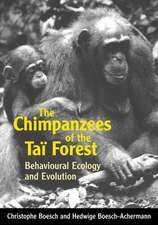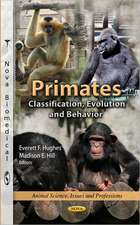Dispersing Primate Females: Life History and Social Strategies in Male-Philopatric Species: Primatology Monographs
Editat de Takeshi Furuichi, Juichi Yamagiwa, Filippo Aurelien Limba Engleză Hardback – 25 iun 2015
To tackle these important questions, this book presents the latest knowledge about the dispersing females in male-philopatric non-human primates and in human societies. The non-human primates that are covered include muriquis, spider monkeys, woolly monkeys, gorillas, chimpanzees, bonobos and some species of colobine monkeys. In these non-human primate species females typically leave their natal group before sexual maturation and start reproduction in other groups into which they immigrate. However, there is a large variation as some females may breed in their natal group with some risks of inbreeding with their male relatives and some females may associate with males of multiple groups at the same time after leaving their natal group. Such variation seems to provide better strategies for reproduction depending on local circumstances. Although knowledge about female dispersal patterns and life history is indispensable for understanding the dynamic structure of primate societies, it is still not known how females behave after leaving their natal groups, how many groups they visit before finally settling down and which kinds of groups they choose to immigrate into, due to the large variation and flexibility and the difficulty of tracking females after natal dispersal.
To encourage further progress in this important field, this volume provides new insights on evolution of female dispersal by describing factors influencing variations in the dispersal pattern across primates and a hypothesis for the formation of human families from the perspectives of female life history. This book is recommended reading for researchers and students in primatology, anthropology, animal behavior and evolution and for anyone interested in primate societies and human evolution.
Preț: 647.40 lei
Preț vechi: 761.65 lei
-15% Nou
Puncte Express: 971
Preț estimativ în valută:
123.88€ • 129.77$ • 102.67£
123.88€ • 129.77$ • 102.67£
Carte tipărită la comandă
Livrare economică 09-23 aprilie
Preluare comenzi: 021 569.72.76
Specificații
ISBN-13: 9784431554790
ISBN-10: 4431554793
Pagini: 299
Ilustrații: XII, 299 p. 68 illus., 43 illus. in color.
Dimensiuni: 155 x 235 x 20 mm
Greutate: 0.61 kg
Ediția:2015
Editura: Springer
Colecția Springer
Seria Primatology Monographs
Locul publicării:Tokyo, Japan
ISBN-10: 4431554793
Pagini: 299
Ilustrații: XII, 299 p. 68 illus., 43 illus. in color.
Dimensiuni: 155 x 235 x 20 mm
Greutate: 0.61 kg
Ediția:2015
Editura: Springer
Colecția Springer
Seria Primatology Monographs
Locul publicării:Tokyo, Japan
Public țintă
ResearchCuprins
Preface (Takeshi Furuichi).- Part I Dispersing Ateline Females.- 1 Dispersal Patterns of Female Northern Muriquis: Implications for Social Dynamics, Life History and Conservation (Karen B. Strier, Carla B. Possamai, and Sérgio L. Mendes).- 2 Association Networks and Life History of Female Spider Monkeys (Yukiko Shimooka).- 3 Social Interactions and Proximal Spacing in Woolly Monkeys: Lonely Females Looking for Male Friends? (Pablo R. Stevenson, Diego A. Zárate, Mónica A. Ramírez and Francisco Henao-Díaz).- Part II Dispersing Hominine Females.- 4 Dispersal Patterns of Females in the Genus Gorilla (Andrew M. Robbins and Martha M. Robbins).- 5 Sex Differences in Ranging and Association Patterns in Chimpanzees in Comparison with Bonobos (Chie Hashimoto and Takeshi Furuichi).- 6 Intergroup Transfer of Females and Social Relationships Between Immigrants and Residents in Bonobo (Pan paniscus) Societies (Tetsuya Sakamaki, Isabel Behncke, Marion Laporte, Mbangi Mulavwa, Heungjin Ryu, Hiroyuki Takemoto, Nahoko Tokuyama, Shinya Yamamoto and Takeshi Furuichi).- 7 Human Female Dispersal and Social Organization: A Case of Central African Hunter-Gatherers (Naoki Matsuura ).- 8 Life History and Sexual Relationships of Female Kalahari Hunter-Gatherers (Kaoru Imamura).- Part III Evolution of Female Dispersal.- 9 Complexities of Understanding Female Dispersal in Primates (Phyllis C. Lee and Karen B. Strier).- 10 Factors Influencing Grooming Social Networks: Insights from Comparisons of Colobines with Different Dispersal Patterns (Ikki Matsuda, Keiichi Fukaya, Cristian Pasquaretta and Cédric Sueur).- 11 Evolution of Hominid Life History Strategy and Origin of Human Family (Juichi Yamagiwa).- BM Conclusion (Filippo Aureli).- Index.
Recenzii
“The volume is enriched by discussion oflongitudinal data from multiple, ecologically variable sites, and chapterauthors provide rich descriptions of their research and thorough syntheses ofthe literature, making the volume helpful for sparking ideas for futureresearch on this topic. … this volume relevant to anthropologists as well asbiologists and primatologists. Summing Up: Highly recommended. Upper-division undergraduates and above.” (L.K. Sheeran, Choice, Vol. 53 (5), January, 2016)
Textul de pe ultima copertă
Why do females in male-philopatric species seem to show larger variation in their life history strategies than males in female-philopatric species? Why did females in human societies come to show enormous variation in the patterns of marriage, residence, and mating activities?
To tackle these important questions, this book presents the latest knowledge about the dispersing females in male-philopatric non-human primates and in human societies. The non-human primates that are covered include muriquis, spider monkeys, woolly monkeys, gorillas, chimpanzees, bonobos, and some species of colobine monkeys. In these non-human primate species females typically leave their natal group before sexual maturation and start reproduction in other groups into which they immigrate. However, there is a large variation as some females may breed in their natal group with some risks of inbreeding with their male relatives, and some females may associate with males of multiple groups at the same time after leaving their natal group. Such variation seems to provide better strategies for reproduction depending on local circumstances. Although knowledge about female dispersal patterns and life history is indispensable for understanding the dynamic structure of primate societies, it is still not known how females behave after leaving their natal groups, how many groups they visit before finally settling down, and which kinds of groups they choose to immigrate into, due to the large variation and flexibility and the difficulty of tracking females after natal dispersal.
To encourage further progress in this important field, this volume provides new insights on evolution of female dispersal by describing factors influencing variations in the dispersal pattern across primates and a hypothesis for the formation of human families from the perspectives of female life history. This book is recommended reading for researchers and students in primatology, anthropology, animal behavior,and evolution, and for anyone interested in primate societies and human evolution.
To tackle these important questions, this book presents the latest knowledge about the dispersing females in male-philopatric non-human primates and in human societies. The non-human primates that are covered include muriquis, spider monkeys, woolly monkeys, gorillas, chimpanzees, bonobos, and some species of colobine monkeys. In these non-human primate species females typically leave their natal group before sexual maturation and start reproduction in other groups into which they immigrate. However, there is a large variation as some females may breed in their natal group with some risks of inbreeding with their male relatives, and some females may associate with males of multiple groups at the same time after leaving their natal group. Such variation seems to provide better strategies for reproduction depending on local circumstances. Although knowledge about female dispersal patterns and life history is indispensable for understanding the dynamic structure of primate societies, it is still not known how females behave after leaving their natal groups, how many groups they visit before finally settling down, and which kinds of groups they choose to immigrate into, due to the large variation and flexibility and the difficulty of tracking females after natal dispersal.
To encourage further progress in this important field, this volume provides new insights on evolution of female dispersal by describing factors influencing variations in the dispersal pattern across primates and a hypothesis for the formation of human families from the perspectives of female life history. This book is recommended reading for researchers and students in primatology, anthropology, animal behavior,and evolution, and for anyone interested in primate societies and human evolution.
Caracteristici
Focuses on an important topic of female dispersal patterns and life history in male-philopatric primate species Provides reviews and new findings for all major female-dispersal species of Atelinae and Hominidae Presents insights on the evolution of female dispersal and human families in a comparative perspective














